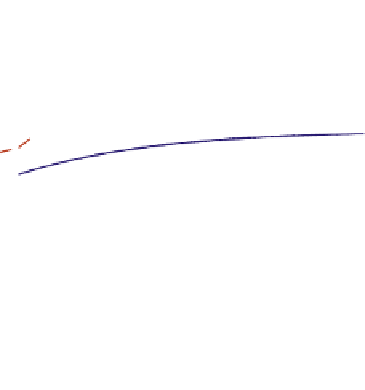Biomedical Engineering Reference
In-Depth Information
(a)
Both species can coexist if there is a common substrate concentration at which both
growth rate of A and growth rate of B are equal, and equal to the dilution rate. That is,
D ¼ m
A
¼ m
B
(E16-7.1)
The growth rates are given by
m
A
¼
m
Amax
S
1
:
5
m
Bmax
S
3K
SB
þS
K
SA
þS
¼
(E16-7.2)
and
m
B
¼
m
Bmax
S
K
SB
þS
(E16-7.3)
Solving
Eqns (E16-7.1) through (E16-7.3)
, we obtain
S ¼ 3 K
SB
and
D ¼ m
A
¼ m
B
¼ 0:75 m
B
max
Therefore, there is a solution to the coexistence problem. It is possible to maintain both
species in the reactor. A sketch of the solution is shown in
Fig. E16-7
.
(b)
Refer to
Fig. E16-7
, because species A has high growth rate that species B, only species A
will survive. At the same dilution rate, the substrate concentration will be driven lower
than species B can survive,
(c)
Refer to
Fig. E16-7
, because species B has higher growth rate at low substrate
concentrations, species B will remain in the reactor.
(d)
The coexistence point cannot be maintained sustainably as it is not a stable solution.
It is clear than when the dilution rate fluctuates away from 0.75
m
Bmax
, one of the
1.4
1.4
µ
A
1.2
1.2
µ
B
1.0
1.0
Co-existence
0.8
0.8
0.6
0.6
0.4
0.4
0.2
0.2
0.0
0.0
0
1
2
3
4
5
1
0
1
0
0
Common Substrate Concentration,
K
SB
FIGURE E16-7













































































































































































Search WWH ::

Custom Search